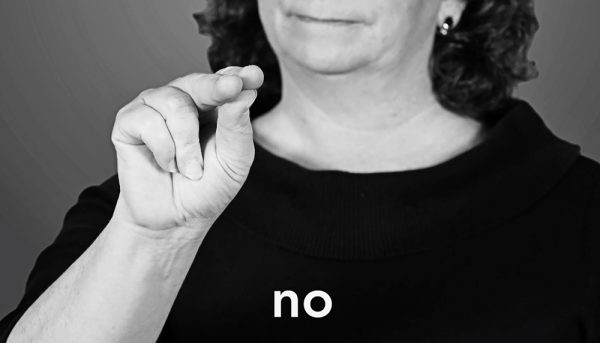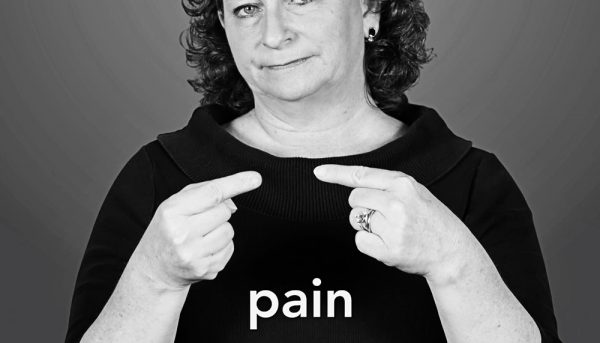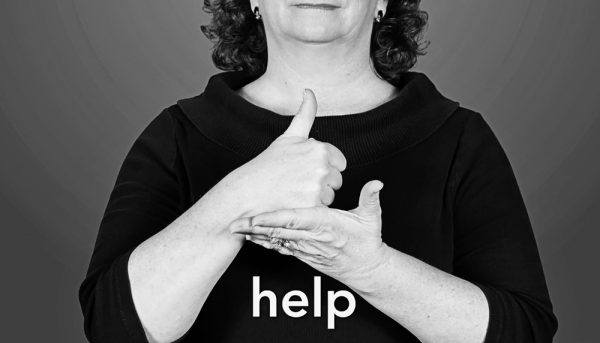My name is Becky Lloyd and God called me “to coordinate the adoption of deaf orphans in the world” on March 18, 2008. Signs for Hope, Inc. (SFH) is an all-volunteer non-profit organization that was established to carry out that call and exists to share the hope of Christ by providing care for deaf orphans in a variety of ways. One of those ways is walking alongside families who are somewhere in the process of adopting a child with deafness. This is a lifelong commitment since adoption is a lifelong journey.
When I was asked to share the top ten most important ASL signs adopting parents could learn prior to meeting their adopted child, I instantly put that same question before the more than 160 families who are connected to us at Signs for Hope, Inc. They know firsthand that teaching hearing and deaf babies sign language helps them to communicate their wants and needs sooner than they can speak them. Likewise, sign language can also be used to help your adopted children express themselves, whether they have hearing loss or not.

Teaching sign language to hearing babies has been growing in popularity in the US over the past 25 years. Knowing sign language helps babies lower their frustrations prior to developing the ability to verbally communicate to mom and dad what they want or need or what is wrong. Adopted children and their families can experience these same benefits when sign language is used to facilitate a smoother communication transition in those first few days, weeks, and months.
Visual communication is a vital tool for your family especially if your new child speaks, writes, or reads in a different language than you do. Sign language has also proven to be an often-accepted and successful mode of communication for children who are nonverbal.
An important aspect of visual communication is the body language (visual to the eye) that is clearly evident in every spoken language around the globe. The exact percentages of how much body language is utilized in a given spoken language is hard to determine, but be assured it is an important component of every language in the world.
If you are adopting a child who is not a native English-speaker, visual communication and body language can go a long way in bridging the communication gap – and facilitating connection – between you and your child before a full, common spoken language is established. Of course, body language is also high for signed languages around the globe, as well.
It was not an easy task for our SFH families to list just ten signs they felt were most important to learn before meeting their Deaf child(ren). Some SFH families are currently struggling with their younger adopted Deaf children who still do not grasp the fact that signs are for communicating needs or wants, so their lists were much shorter than others. But, all agreed: some signs naturally came up more often.
Below is a list of the top ten signs – some I have shared in more detail while others are more self-explanatory. Two of these ten signs are actually two signs with opposite meanings, so we have chosen to combine them and call them “one sign” for our purposes here. These pairs of counter signs are “mom/dad” and “no/yes.” I have also created a short video where I model these top ten signs for you to see – you can start practicing today!
1. yes/no


It’s true, “yes” and “no” could simply be communicated by a headshake or a head nod instead of using the sign for each. But, be aware in some cultures these head movements have opposite meanings compared to our common understanding of them in the United States. Bulgarians, for example, nod the head up and down for “no” and shake side to side for “yes.” Furthermore, the use of signs with often-repeated words like “yes” and “no” can help condition you and your child to using sign language more overall. The more you sign, the more you communicate! And the more likely your child will communicate with you.
An additional note about “no” and “yes”: try to create scenarios where you use the “no/yes” signs in a context that is not related to something your son or daughter is emotionally attached to, like inappropriate behavior or during times of needed correction. For example, you could use them when teaching the signs for colors. And you could use them when teaching the different signs for food and clothing (see how hard it is to keep this list to just 10 signs! *wink*) Teach the signs themselves first. Once those are clearly understood and your child can match the sign with the color or object begin to make it a game using the signs for “yes” and “no” to confirm and negate which sign represents which color or object and which one does not. Basically, this is the natural way a child learns to associate the labels/names for certain things and how they begin to learn the meaning of “no” and “yes”. This will help communicate the broader meaning of “no/yes” in a neutral context, separate from your child’s behavior. Keep in mind, it will take many repetitions for most children to make this association and many more repetitions for them to begin to copy the sign(s) and/or speak the words. So, don’t give up!
2. mother/father


You may think that teaching the signs “mom” and “dad” could be inappropriate for a newly adopted child, especially if the child being adopted already attaches strong personal meaning to these labels. These signs are extremely useful, however, for simply naming important persons in the household and for introducing yourself.
Each family will have to decide if the use of “mom” and “dad” can simply be used for communication purposes at first, while allowing their son or daughter the right to embrace those labels for you fully when they are ready.
3. potty

In ASL there are several signs for communicating specific bodily functions, which take place in the bathroom. Simply shaking the hand while making the ASL handshape “t” which can represent the English letter “t” for toilet — is sufficient for teaching your adopted child this vital concept. This sign conveys the place where those bodily functions should appropriately take place without the graphic detail of additional specific signs.
Furthermore, this sign can represent either a toilet or a bathroom with a toilet, squatty or not, depending on where your adopted child spent his/her toilet training years. It is very possible that your older adopted son or daughter already has a gesture they use to communicate their urgent need for using a bathroom. If you are wondering what that gesture might look like be assured that when they physically hold the area where this bodily function urge occurs, either in front or back, the need will be clear. Be assured this holding will not be discreet. No doubt, you will be relieved when they do learn the meaning of this sign for “potty” and use it instead.
4. food

5. drink

6. more

7. pain

8. finished

9. help

10. water

Be sure to watch the informative video in which these top ten signs are modeled – these signs are not accurately represented by a single image.
A few additional comments about visual communication, sign language, and the adopted child:
Pointing is a huge part of American Sign Language. It is not considered rude in Deaf culture to point to a person or object when describing or naming it. Furthermore, pointing is constantly utilized when teaching young children (both hearing and deaf) to identify a specific object or person. By pointing, we teach young children, including the adopted child, to recognize the word used for that object and in turn help to make a concrete word association. This is an especially common occurrence when reading with very young children.
In those first days with your adopted son or daughter, your repeated pointing followed by forming the sign for whatever you are pointing out, will be vital for helping communicate to him or her the name or label for things. This is also one of the fastest ways to help them understand “who” a person is.
Try this “Copy Me” game to reinforce this concept: point to yourself, then complete an action you want your child to mimic or copy. Then, point to your child as a signal for them to copy your action. Using additional family members to play this game will make this more fun and engaging for all. Repeat this as often. For example, if you want your child to sit beside you, point to yourself and sit down. Then, point to your child and point to or pat where you want him or her to sit down. Remember, some Asian cultures do not permit sitting on the floor, but instead squat. Knowing some of the basic cultural differences of your adopted children will help eliminate some early misunderstandings, too. Some of your adopted children will not be able to be still long enough for these two-step directions to be given, do it anyway. Your repetition of a sign or gesture will eventually click, even if your child only sees it in their peripheral vision.
As you can imagine, the use of tangible objects makes this word-association much easier and often faster. Pointing to a chair, for example, while signing and saying chair before having your child sit down. Having pictures of things that may not be as readily available is also wise for those first days and weeks together. A picture chart of common foods will be helpful to create and take with you. Of course, learning the signs for those foods would also be of great benefit and help to increase that much desired eye contact between you and your child. Again, ten signs are not enough!
Feelings and emotions will be difficult during those first few days, weeks and beyond. An emotion chart, flash cards or a ring with pictures of real children displaying certain emotions is highly recommended. This visual will help your adopted child begin to understand what it is they are feeling and when. It will give them another way of showing how they feel at a given time, instead of using an unacceptable behavior to show their feelings.
Basically, these visuals of various emotions are very similar to the body language utilized with the ASL sign when making the handshape and movements of the sign. Many signs that represent emotions tend to be iconic. While identifying these emotions and feelings will help you to better communicate with each other, it may be years before your adopted child can actually tell you why they are feeling a certain way and for some this may never be possible.
The use of imitation for your adopted children is vital. Imitation, sometimes called copying, mirroring or mimicking, is a major natural part of a young child’s development, and something many of your adopted children have missed out on. Imitation occurs in natural play situations among even young children without being prompted when children “play at” or “act out” something they have seen or experienced. This is another reason why the use of gestures and mime can be of great benefit for communicating information you want your adopted child to understand and do.
Many children do respond to signs alone, but some do not. In fact, most children will better receive the use of signs when they are combined with gestures and mime. Moms and dads sometimes have to be very creative when it comes to gestures in getting their desired communication across.
There are many “gestures” which we use that are considered universal and will easily communicate to a child the information you want them to understand (such as pointing, discussed above). Be aware, just because they may understand what you are communicating does not always mean they will comply.
Language deprivation will likely be a characteristic of the vast majority of your children when adopted because of various interruptions in their early, most-important developmental stages. This along with the other possible effects of a stressful pregnancy for mom, drug and/or alcohol use by mom, premature birth, abandonment, institutionalization and/or multiple placements will contribute to the emotional, social, and cognitive delays your adopted children will exhibit. Remember that every child is unique and the ways in which they handle their past will be just as unique.
Children who have been with us since birth observe our every move in that natural visual environment of the everyday. In fact, it is often those things we do not want them to learn from us that they learn simply by observation! Your adopted children have unfortunately missed out on much of this natural development, cognitively and verbally. Even if they have had the benefit of a foster family, the cultural differences will possibly be great. There are ways to go back and help them experience a more “natural” language and cognitive development process and utilizing their visual environment will have great impact in doing so.
Remember again – it is very probable some of these sign-concepts will have to be introduced multiple times and often modeled by you repeatedly before your child achieves word-association and comprehension. Concrete concepts will typically be much easier to grasp than abstract ones (i.e. labeling a chair v. explaining patience). For those of you who are introverts, this constant modeling may be more of a challenge for you. And when I say multiple times, I mean at least 20 times per day by every family member for the first three months. That is the minimum. This still will not equal the interactions your adopted son or daughter missed out on early on, but it will help them to go back and capture some of what they missed.
Holding very loosely to your adopted child’s chronological age will help you better connect with them early and progressively with fewer unrealistic expectations. One of the most challenging things to constantly be mindful of is how much your adopted sons and daughters have missed out on in the “real world” and how young they really are. This is especially true because they inhabit the physical body of a much older and larger child – the visual that is constantly before you – and that typically tells you something intuitive about age and presumed experience level; when in reality, the mind, emotions and vocabulary of a much younger, much less-experienced child are inside. Unfortunately, this will also be something many others will often forget, as well.
The sooner you identify your adopted child’s cognitive, emotional, and social level of development and need, treat them appropriately and help others do the same, the sooner you will likely see improvements and growth in these three areas, along with language development.
I often tell our SFH families to think of their adopted child with deafness as if they were born the first day they are yours. This would be of benefit for all adopted children and their families. While this is not a perfect analogy because your adopted children have unfortunately been forced to develop and mature in the area of “survival” and “street smarts” because of the deprivations and experiences caused by the above-mentioned traumas, it will be a more realistic one. Diffusing unrealistic expectations surrounding your adopted child will help to minimize your own stress which will in turn show clearly in the body language you exhibit toward him or her.
Herein lies another reason why visual communication is the fastest and easiest way to help you relate to your adopted son or daughter. In the midst of some deficiencies, your children have been daily experiencing their world visually. While their visual comprehension of what they have experienced will not be truly accurate – and is often completely inaccurate! – they have still been utilizing the visual since birth. We can use this natural “given” to facilitate better and sooner communication, despite delays and difficulties in other developmental areas.
Of course, experiencing the world visually is not a “given” for a child who has visual limitations. There are, however, other creative ways of communicating with children who have visual limitations and even for those who have deafness and blindness at the same time. Signs for Hope supports families of adopted DeafBlind children, too. Please contact me for more information surrounding these fascinating emerging techniques and any other questions you may have.
Obviously, learning ten words in sign language is just the beginning of the possibilities for communicating visually with your newly adopted child. Furthermore, it is very possible your son or daughter could easily learn as many as 30 signs in those first weeks together, if you know them in advance and sign freely. Anytime you can increase the interactions between you and your adopted child with this level of communication (information giving, receiving and comprehension), more “connection” is happening.
I hope these ten signs will only serve to whet your appetite for learning more! If I can be of any help to you, please do not hesitate to contact me. The Signs for Hope website and the blog might also be of some benefit to you. Finally, if you want additional information on the various supports we offer families who are in the process of adopting a child with deafness or deafblindedness, please just ask!
 Becky Lloyd is the founder of and full time volunteer at Signs for Hope, Inc. (501c3). She also works part time as an American Sign Language (ASL) freelance interpreter in Asheville, NC. She is a nationally certified ASL Interpreter (NIC) with experience in a variety of interpreting settings including medical, educational and religious. In addition, Becky is a trained TBRI® Educator and presenter for the National Center for Biblical Parenting. She earned her BS degree from Gardner-Webb University in 2008 with a major in ASL Studies and a minor in ASL Interpreting.
Becky Lloyd is the founder of and full time volunteer at Signs for Hope, Inc. (501c3). She also works part time as an American Sign Language (ASL) freelance interpreter in Asheville, NC. She is a nationally certified ASL Interpreter (NIC) with experience in a variety of interpreting settings including medical, educational and religious. In addition, Becky is a trained TBRI® Educator and presenter for the National Center for Biblical Parenting. She earned her BS degree from Gardner-Webb University in 2008 with a major in ASL Studies and a minor in ASL Interpreting.

























This is wonderful and valuable basic information. Thank you for sharing and educating us!